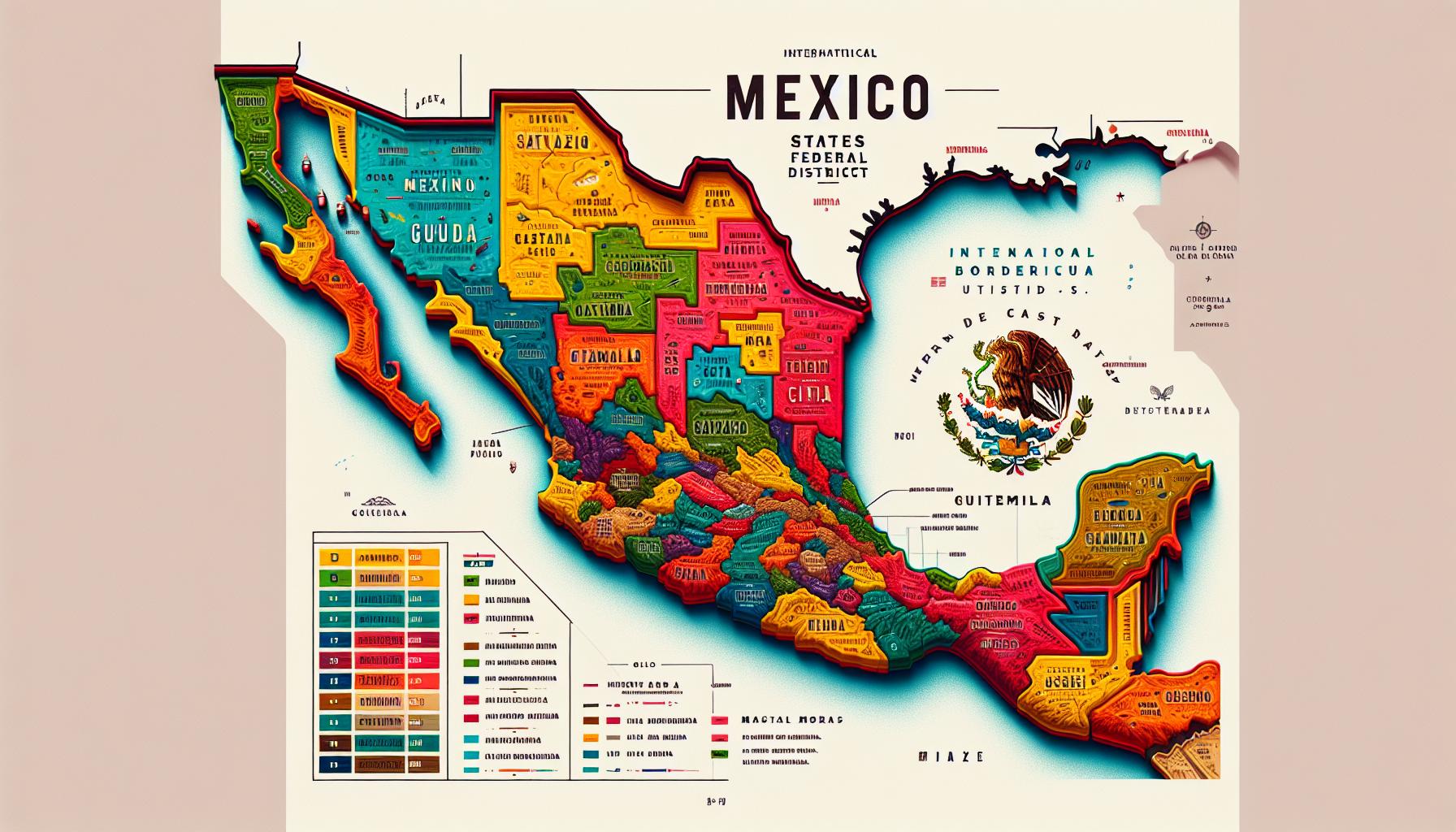Mexico’s vibrant tapestry of states unfolds across a diverse landscape that’s as colorful as its rich cultural heritage. From the sun-kissed beaches of Baja California to the ancient Mayan ruins of Yucatan, each of Mexico’s 32 states tells its own unique story.
Understanding Mexico’s political geography isn’t just about memorizing boundaries – it’s about discovering how these distinct regions shape the nation’s identity. Whether you’re planning a cross-country adventure or simply expanding your knowledge of North American geography, mastering Mexico’s state map opens doors to understanding this fascinating country’s regional diversity, economic patterns, and cultural traditions.
Estados:unvbstvkr1u= Mapa de México
Mexico’s political map divides into 32 distinct federal entities: 31 states plus Mexico City as the capital. The northern states include Baja California Norte, Baja California Sur, Sonora, Chihuahua, Coahuila, Nuevo León, Tamaulipas sharing borders with the United States.
Central Mexico encompasses states such as Aguascalientes, Guanajuato, Querétaro, Hidalgo, México State, Tlaxcala, Morelos forming the economic core of the nation. The Pacific coastal region features Sinaloa, Nayarit, Jalisco, Colima, Michoacán, Guerrero, Oaxaca, Chiapas with diverse climates ranging from tropical to temperate.
- Northern Desert Region
- Chihuahuan Desert spans across multiple states
- Mining centers in Zacatecas Durango
- Industrial hubs in Monterrey San Luis Potosí
- Central Highlands
- Colonial cities in Puebla Guanajuato
- Agricultural valleys in Bajío region
- Mexico City metropolitan zone
- Coastal Regions
- Gulf Coast states: Veracruz Tabasco Campeche
- Pacific states with major ports
- Yucatán Peninsula: Yucatán Quintana Roo
| Region | States | Key Features |
|---|---|---|
| North | 7 states | Desert climate industrial zones |
| Central | 13 states | Volcanic belt colonial heritage |
| South | 6 states | Tropical forests Mayan culture |
| Coastal | 6 states | Beach tourism port cities |
The territorial organization reflects Mexico’s geographic diversity with each region maintaining distinct economic activities cultural traditions administrative systems. State boundaries often follow natural features like mountain ranges rivers creating logical divisions in the landscape.
Key Geographic Regions of Mexico

Mexico’s distinct geographic regions showcase diverse landscapes from arid deserts to tropical rainforests. These regions shape the cultural identity economic activities of their respective states.
Northern States
The northern region encompasses nine states bordering the United States stretching from Baja California to Tamaulipas. This area features extensive desert landscapes including the Sonoran Desert Chihuahuan Desert. Major industrial centers like Monterrey Ciudad Juárez drive manufacturing exports. The region’s states include:
- Baja California: Home to wine valleys border industries
- Chihuahua: Contains the Copper Canyon extensive mining operations
- Coahuila: Features automotive manufacturing centers vast rangelands
- Nuevo León: Houses Mexico’s industrial capital Monterrey
- Sonora: Known for agriculture mining along the Sea of Cortez
Central States
Central Mexico contains the country’s capital densely populated urban areas. The Mexican Plateau dominates the landscape with volcanic peaks fertile valleys. Notable features include:
- Mexico City: The national capital cultural hub
- Guanajuato: Colonial architecture automotive industry clusters
- Jalisco: Tequila production tech innovation centers
- Querétaro: Aerospace manufacturing historical monuments
- State of Mexico: Industrial zones archaeological sites
- Chiapas: Lacandon Jungle indigenous communities
- Oaxaca: Monte Albán ruins traditional markets
- Yucatán: Chichén Itzá Mayan cultural heritage
- Quintana Roo: Caribbean coastline coral reefs
- Campeche: Colonial fortifications petroleum industry
Major States and Their Capitals

Mexico’s largest state by population, Estado de México, houses 17.3 million residents with Toluca serving as its capital city. Jalisco, centered around its capital Guadalajara, ranks third in population with 8.3 million inhabitants across its diverse landscape.
| State | Capital | Population (Million) |
|---|---|---|
| Estado de México | Toluca | 17.3 |
| Ciudad de México | – | 9.2 |
| Jalisco | Guadalajara | 8.3 |
| Veracruz | Xalapa | 8.1 |
| Puebla | Puebla | 6.6 |
Nuevo León’s capital Monterrey functions as a major industrial hub connecting northern Mexico’s economic corridor. Veracruz, with its capital Xalapa, stretches along the Gulf Coast featuring Mexico’s largest port facilities. Puebla capital city, also named Puebla, stands out for its colonial architecture spanning 70 city blocks.
Key economic centers include:
- Guadalajara’s technology manufacturing district
- Monterrey’s steel production facilities
- Puebla’s automotive assembly plants
- Veracruz’s maritime shipping terminals
- Toluca’s industrial parks
Cultural landmarks distinguish these capitals:
- Metropolitan Cathedral of Xalapa
- Hospicio Cabañas in Guadalajara
- Macroplaza in Monterrey
- Puebla’s Historic Center
- Cosmovitral Botanical Garden in Toluca
These state capitals represent administrative centers managing Mexico’s largest populations across industrial manufacturing tourism cultural sectors. Each capital maintains unique architectural elements reflecting regional history traditions economic focus.
Political Boundaries and Territories

Mexico’s political structure encompasses 31 states plus one federal district, creating a complex territorial organization that reflects its historical development and administrative needs.
Federal Districts
Mexico City serves as the nation’s capital and operates as a distinct federal district. The district spans 1,485 square kilometers with 16 administrative boroughs managing local affairs. Since 2016, Mexico City gained enhanced autonomy equivalent to a state, allowing it to establish its own constitution and maintain independent governing bodies. The district houses federal government institutions, major financial centers and cultural landmarks like the National Palace and Zócalo square.
International Borders
Mexico shares international borders with three countries spanning 4,353 kilometers. The northern border with the United States extends 3,145 kilometers through six Mexican states: Baja California, Sonora, Chihuahua, Coahuila, Nuevo León and Tamaulipas. The southern border connects with Guatemala across 956 kilometers through Chiapas, Tabasco and Campeche. A shorter 252-kilometer border links Mexico to Belize through Quintana Roo. These boundaries feature designated crossing points, immigration controls and specialized economic zones that facilitate international trade.
| Border Country | Length (km) | Mexican States |
|---|---|---|
| United States | 3,145 | 6 states |
| Guatemala | 956 | 3 states |
| Belize | 252 | 1 state |
Cultural and Economic Diversity Across States
Mexico’s states reflect distinct cultural patterns through their economic activities, traditional celebrations, and regional customs. Each region showcases unique industries: automotive manufacturing dominates Puebla, technology centers thrive in Jalisco, and tourism flourishes in Quintana Roo.
Northern states focus on manufacturing, with Monterrey operating as a major industrial hub featuring steel production, automotive assembly, and technology parks. Border states maintain strong economic ties with the U.S. through specialized trade zones and maquiladora operations.
Central Mexico balances tradition with modernity:
- Guanajuato preserves colonial architecture while hosting international arts festivals
- Querétaro combines aerospace industries with historic downtown districts
- Estado de México blends indigenous crafts with modern commercial centers
The southern region maintains strong indigenous influences:
- Oaxaca features 16 recognized ethnic groups with distinct languages
- Chiapas combines Maya cultural sites with coffee production
- Yucatán integrates henequen farming with cultural tourism
| Region | Primary Industries | Cultural Highlights |
|---|---|---|
| North | Manufacturing, Mining | Cowboy Culture, Norteño Music |
| Central | Services, Technology | Colonial Architecture, Traditional Markets |
| South | Agriculture, Tourism | Indigenous Festivals, Traditional Crafts |
| Coastal | Fishing, Tourism | Regional Cuisine, Maritime Traditions |
Coastal states demonstrate economic diversity through:
- Veracruz’s port operations paired with vanilla cultivation
- Sinaloa’s agricultural exports alongside fishing industries
- Baja California’s wine production combined with beach tourism
These regional variations create economic clusters that shape local traditions, culinary practices, and artistic expressions across Mexico’s territory.
Historical Evolution of Mexico’s State Borders
Mexico’s territorial divisions underwent significant transformations from the pre-colonial era through modern times. The Spanish colonial period established administrative regions called intendencias in 1786, creating 12 distinct territories that laid the foundation for today’s states.
The first Mexican Constitution of 1824 established 19 states following independence from Spain, including:
| Year | Number of States | Key Changes |
|---|---|---|
| 1824 | 19 states | Initial post-independence division |
| 1857 | 23 states | Addition of frontier territories |
| 1917 | 28 states | Formation of new states |
| 2023 | 31 states + CDMX | Current configuration |
Major territorial changes occurred during the 19th century. Texas separated in 1836, while the Treaty of Guadalupe Hidalgo in 1848 redefined the northern border after Mexico ceded territories to the United States. The French intervention (1861-1867) temporarily disrupted state boundaries before their restoration under President Juárez.
The Revolution of 1910 catalyzed further administrative reorganization. Quintana Roo gained statehood in 1974, marking the last territorial addition to Mexico’s current 31-state configuration. Mexico City evolved from a federal district to an autonomous entity in 2016, completing the modern political map.
Several states emerged from larger territories:
- Guerrero separated from México State in 1849
- Hidalgo formed from México State in 1869
- Morelos established from México State in 1869
- Nayarit transformed from territory to state in 1917
- Baja California Sur achieved statehood in 1974
These divisions reflect geographic features, historical developments, demographic patterns, and administrative needs that shaped Mexico’s current political landscape.
Vibrant Picture
Mexico’s 32 states paint a vibrant picture of cultural heritage economic diversity and geographical wonders. Each region from the industrial north to the tropical south contributes uniquely to the nation’s identity through distinct traditions economic activities and natural landscapes.
Understanding Mexico’s political geography reveals more than just boundaries – it showcases how the country’s rich tapestry of states has evolved through historical events natural formations and administrative needs. This complex network of regions continues to shape Mexico’s development as a dynamic and multifaceted nation.
Mexico stands as a testament to how political boundaries can reflect both natural geography and human endeavor creating a fascinating blend of tradition and progress that defines modern Mexico.



